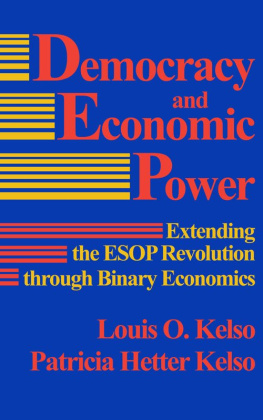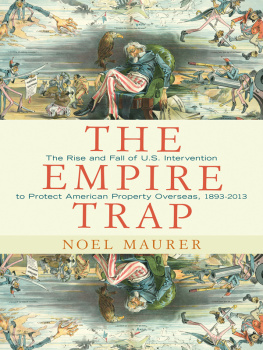
Copyright 1986, 1991, 2013 by Louis O. Kelso and Patricia Hetter Kelso
All rights reserved
Printed in the United States of America
Library of Congress Cataloging-in-Publication Data
Kelso, Louis O.
Democracy and economic power: extending the ESOP revolution
through binary economics / Louis O. Kelso, Patricia Hetter Kelso.
p. cm.
Originally published: Cambridge, Mass.:
Ballinger Pub. Co., 1986
Reprinted: Lanham, Maryland:
University Press of America, Inc., 1991
Includes index.
1. Industrial managementUnited StatesEmployee participation.
2. Employee ownershipUnited States.
3. Trade-unionsEconomic aspectsUnited States.
4. Income distributionUnited States.
I. Kelso, Patricia Hetter II. Title
List of Figures
| Says Law as Applied to a National Economy |
| Says Law Corrected to Recognize Both Labor Work and Capital Work |
| The Employee Stock Ownership Plan (ESOP) |
| The Mutual Stock Ownership Plan (MUSOP) |
| The Consumer Stock Ownership Plan (CSOP) |
| The AGSOC Purchase of the Interest of the BP Pipeline, Inc.in the TransAlaska Pipeline (TAPS) |
| The Individual Capital Ownership Plan (ICOP) |
| The Commercial Capital Ownership Plan (COMCOP) |
| The Public Capital Ownership Plan (PUBCOP) |
| The Residential Capital Ownership Plan (RECOP) |
| Democratic Commercially Insured Contract Financing of Capital Transactions |
| Changing Participation of Labor and Capital Workers in Production of Goods and Services in the U.S. Economy |
Preface
A basic truth is not invented but discovered. The more basic and universal it is, the more obvious it is apt to be and the harder to perceive, even though, like Poe's purloined letter, it lies in full view. Once found, its existence seems natural and inevitable. Everyone silently thinks, "How could I have missed that?"
Such a basic truth is the nucleus of this book.
Two-factor economics began as a young man's insight in the depths of the Great Depression. It grew into a manuscript entitled "The Fallacy of Full Employment," which happened to be completed just at the end of World War II when the Full Employment Bill of 1945 was on the verge of becoming law. If it is true that nothing is as powerful as an idea whose time has come, it is equally true that an idea whose time has not come will get no hearing. The manuscript was quietly put away until 1958 when Mortimer Adler persuaded the author to join with him and publish its essentials as The Capitalist Manifesto.
The Capitalist Manifesto asked Americans who thought they had solved the economy's income distribution problem through the mixed capitalist-socialist economy to think again about the implications of distributing through labor the ever growing stream of capital-produced income, as contemplated by the nation's official economic policy. In 1961, The New Capitalists criticized savings-based finance and proposed a financed capitalist plan. In 1967 Two-Factor Theory: The Economics of Reality launched the Employee Stock Ownership Plan (ESOP) movement. But still the investment banking world remained largely oblivious to the challenge of expanding America's ownership basedemocratizing its economic poweruntil our founding of Kelso & Company in 1970.
Almost as frustrating as identifying a new basic idea is giving it the right name. In a field as old as political economics, such basic terms as democracy, capitalism, market, factors of production, etc., are not only scholarly property but encrusted with meanings and associations. Should an innovator make up a new term or stretch the meaning of an established one? In succession we usedthen discarded: the theory of capitalism, capital theory, two-factor theory, Second Income Plan, universal capitalism, social capitalism and democratic capitalism.
Finally, the term for which we had been searching for almost 50 years announced itself: ''binary economics." But this did not occur until after Democracy and Economic Power had been published. There is no gainsaying, however, that it is the right term. It implies that the labor theory of value, explicit in classic economics, implicit in modern, no longer fits the facts; that capital instruments must be recognized equally with labor as an input factor, thus transforming economics from a mono-system to a binary one.
Louis O. Kelso
Patricia Hetter Kelso
San Francisco
July 1990
AUTHORS' INTRODUCTION TO THE
NEW EDITION
The Search for the Obvious Intensifies
After 70 years of trying to make its government-owned, centrally planned economy work, the Soviet Union has formally abandoned the effort. Upon the ashes of the failed Marxist-Leninist economic experiment, the Soviets and the equally disillusioned Eastern Europeans are planning to construct the only other apparent alternative, a private-property, free-market economy.
The West not unnaturally interprets this astonishing conversion as a pragmatic and ideological victory for the economic system which the Marxist-Leninists vowed to destroy, and for most of the present century did their best to destroy. It has magnanimously dispatched cadres of free-market missionariesbankers, economists, accountants, lawyers, marketers, stockbrokers, communicators and various other presumably indispensable professional talentsto rehabilitate the fallen Marxists. Indeed, President Bush has proposed that the United States organize task forces for this altruistic undertaking.
But the Western market economies, enviable as they may seem to those still mired in varying stages of preindustrial poverty or post-industrial socialist poverty, are not successful working models for large and growing numbers of their own citizens. Not only have they not eradicated the chronic poverty that has always shadowed the base of the social pyramid, poverty is now beginning to claim growing numbers of the middle classes. The United States Government estimated that in 1989, 36 million people were below the poverty threshold of $11,611 for a family of four. The proportion of New Yorkers classified as poor has risen from 15 percent in the mid-1970s to 25 percent today. And we must keep in mind that government, not the people themselves, defines poverty in such a way as to keep the poor as invisible as possible.
It is now expected that mothers of small children will have to work outside the home. Two or more incomes are necessary to attain the standard of living a single breadwinner once could command. In 1950, seven out of ten Americans could afford an average new home. As the 1990s open, uncounted millions of Americans are homelessamong them an admitted one million children.
That poverty is the mother of crime," as the Roman historian Marcus Aurelius Cassiodorus pointed out, has been recognized since antiquity. In 1987, almost three and one-half million adults were under the custody of federal, state and local correctional authorities, including men and women in prisons and jailsalmost 2 percent of the nation's adult population. A Justice Department official (Joseph Bessette, acting director, Bureau of Justice Statistics, an arm of the Justice Department) estimated that one out of every 53 adults in the United States was under some form of correctional supervision on any given day in 1987. The number of adults in the U.S. on parole rose 11 percent from 1986-87.
But the most incontrovertible evidence of the traditional market economy's unworkability is provided by the diverse and growing deficitsfederal budget deficit, trade deficit, city, county and state budget deficitswhich are making it increasingly impossible for governments at every level to function. As we write, the United States budget deficit is estimated as in the range of $184 to 206 billion for the 1991 fiscal year, augmenting a three trillion dollar national debt and off-balance sheet liabilities of over $10 trillion.
Next page









